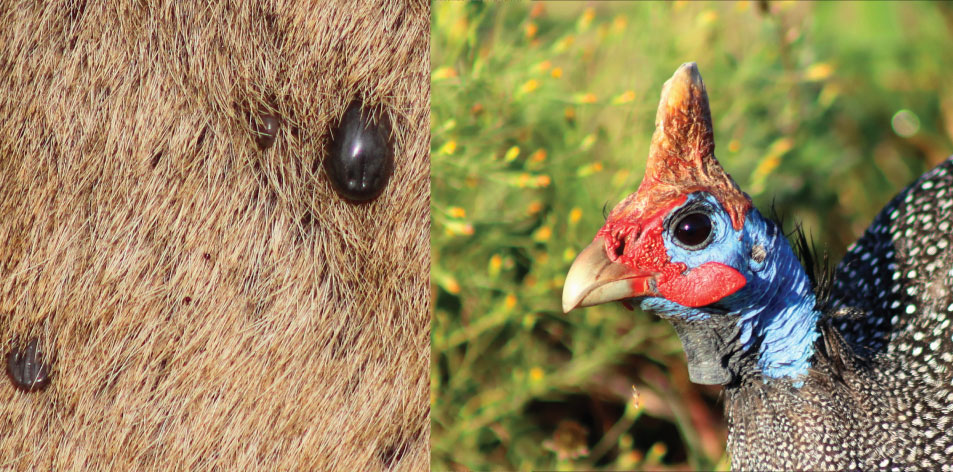
The Lion’s Friend!!- Article by Gareth Jones
The Lion’s Friend In The Nairobi National Park
Sometimes there are times when I look for really small things. Some time ago, I found an older lioness lying next to the road in the Nairobi National Park, she was covered with many ticks. For a brief moment in time, I tried to imagine life from the viewpoint of a tick. Seemingly waiting on dry blades of grass for weeks on end, for their eventual unwitting hosts to pass by and give them a “lift” so that they could have their safari journey for “suck”-cess as they feed on the blood of the host. Ticks often repeat the act of attaching to various hosts as they travel around during their “safari” lifecycle, as they grow from nymph to adult stage to achieve their “suck”-cess.
Early one morning on a game drive in the Nairobi National Park, we sat and observed a flock of Helmeted Guineafowl for a while. They are interesting to watch as they make their “rough rusty-rattle” calls and then repeatedly peck at the ground for hours to find food. There are six known species of Guineafowl in Africa, with Kenya being blessed with three of them, namely the Crested Guineafowl, Vulturine Guineafowl and the Helmeted Guineafowl of the family Numididae.
The helmeted guineafowl (Numida meleagris) are found in many parts of Kenya, including the Nairobi National Park with the subspecies of helmeted Guineafowl known as “Reichenow’s Guineafowl” (Numida meleagris reichenowi), showing characteristically bright, tricolour head pattern of orange-brown casque, bright aqua “bluetiful” cheek and neck, and red “handlebar moustache”. There are nine recorded subspecies of helmeted guineafowl across Africa. Typically, flocks of about 25 birds roost communally. They can walk over 10 km a day, and are well-suited for running while maintaining dynamic stability over rough terrain at speed.
Interestingly, scientists have recorded about 900 different types of ticks in nature, they are small arachnids and are therefore not insects but are related to spiders as they also have eight legs. Ticks are external parasites, living by hematophagy on the blood of mammals, birds, and sometimes reptiles and amphibians. Ticks carry of a number of diseases, including African tick bite fever, tick-borne relapsing fever, babesiosis, and Tick paralysis.
Guineafowl play a major role in the process of reducing pests such as ticks. Ticks carry diseases, like micro biological pathogens. Guineafowl are indirectly one of the best friends that lions could ever have. They eat thousands of ticks that are not on animals, by continuously searching and scratching on the ground. Guineafowl should be appreciated more due to their special role in pest reduction.
Micro biological pathogens can cause serious disease, especially in a weakened host, and can even result in death. One recorded case is the death of the famous lioness “Elsa” well known for the Kenyan classic lion film “Born Free”, who died in the Meru National Park after being infected with tick bite fever due to not having resistance to the babesia leo protozoan parasites. It is thought that Elsa had weak immunity to ticks due to being hand reared from when she was a cub. Some years ago we drove past Elsa’s gravestone, that Joy Adamson had built, to ensure in her memory. It should be noted that healthy wild lions have a strong enough immune system to resist babesia leo protozoan parasites.
Ticks (suborder Ixodida) are parasitic arachnids that are part of the superorder Parasitiformes. Along with mites, they constitute the subclass Acar I. Ticks are therefore not actually insects and are more closely related to spiders, as they also have eight legs. Ticks are major disease carrying pests, particularly in many parts of Africa. There are two main groups of ticks, namely the Ixodidae or hard ticks, and the Argasidae, or soft ticks. Interestingly, there are about 900 different types of ticks in nature.. Ticks are external parasites, living by hematophagy on the blood of mammals, birds, and sometimes reptiles and amphibians. Ticks carry of a number of diseases, including African tick bite fever, tick-borne relapsing fever, babesiosis, and Tick paralysis. However, I’m very sure that this meaningful information on ticks is of the least concern to guineafowl. No doubt these hardy birds don’t care about tick information, they simply eat them.
There is a somewhat indirect beneficial relationship involves guineafowl and their role in the reduction of ticks. It can even be said that Guineafowl are one of the best friends that lions could ever have, even through all lions are completely unaware of the benefit they have from the actions of guineafowl. The guineafowl eat thousands of ticks that are not on animals, by continuously searching and scratching on the ground. Guineafowl often travel behind herd animals and beneath monkey troops, where they forage within manure and on items that have fallen to the understory from the canopy. They play a pivotal role in the control of ticks, flies, locusts, scorpions, and other invertebrates. Next time you see guineafowl you will hopefully appreciate them more due to their special role in pest reduction, and the fact that they indirectly play a role in improving the health of species like lions.
Sometimes, we humans do not even begin to understand many of the complex interactions that take place in nature. We often take some species for granted, if there were no longer guineafowl around, tick populations would simply explode as there would be fewer species like ox-peckers to control them. So next time you see a flock of guineafowl, why not spend a bit of time watching these wonderful creatures? Irrespective of if you see lions or not, at least you will have observed the “lion’s friend” in action, as they tirelessly continue to keep pest populations like ticks under control.


